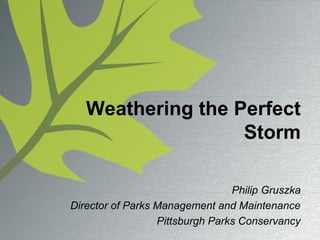Weathering the ŌĆ£Perfect StormŌĆØ
- 1. Weathering the Perfect Storm Philip Gruszka Director of Parks Management and Maintenance Pittsburgh Parks Conservancy
- 2. Tree action plan Started in 2002 With EAB reported In Detroit
- 3. 2005 street tree inventory completed less than 300 ash trees
- 4. 2007 park landscape tree inventory competed less than 200 ash trees
- 5. Natural Areas Study of City Parks completed in 2010 981 acres of woodlands ŌĆś 53 tree species 414 trees per acre 372,873 trees
- 6. Native tree species Green and White ash (15.2%) Red Oak group (12%) Black cherry (9 %) sugar maple (8.6%)
- 7. Non-native invasive trees Norway maple (17.6%) Tree-of-heaven (5.9%)
- 10. Pittsburgh woodlands are 6270 acres almost 10 square miles
- 12. Public land (NAS) 388,125 Ash Trees
- 13. Red Oak Group 310,500 trees
- 14. Ash and oaks = 698,625 x 2500 gallons storm water mitigation per tree = 1,746,562,500 1.75billion gallons
- 15. Combined Sewer
- 16. Landslide
- 21. Gypsy moth
- 22. Beech Bark Disease This a complex involving an invasive, soft scale insect and fungus.
- 25. STREET TREES Norway maple callery pear London planetree sugar maple silver maple other 16% 11% 9% 4% 3% 23% red maple littleleaf linden honeylocust pin oak sweetgum 11% 11% 5% 4% 3%
- 26. PARK TREES pin oak northern red oak crabapple ginkgo littleleaf linden Austrian pine 11% London planetree 6% Norway maple 4% 4% black locust 4% sugar maple 2% other 6% 5% 4% 3% 50%
- 27. COMPLETE URBAN FOREST black locust 13% Norway maple black cherry 11% white ash American elm 8% tree-of-heaven boxelder 5% sugar maple hackberry 2% white mulberry other 30% 12% 9% 5% 3% 2%
- 28. Natural area study 414 trees per acre (981 acres) (6270) Urban forest master plan 73 trees per acre (35,520 acres) 9% ash = 233,366 1.4% red oak = 36,301 (388,125) (310,500)
- 29. Ash and oaks = 698,625 (NAS) 1,746,562,500 1.75billion gallons Ash and oaks = 269,667 (UFMP) 674,167,500 million gallons
- 30. Historic, landscape or woodland specimen free of defects small groups of males and females diverse locations
- 31. Ash is a battle that we lose
- 34. No preemptive cutting of ash
- 35. This is a battle we can win
- 36. Park Trees Red oak group 12% 48,736 trees
- 38. Picnic beetle long distance vector root graft local transmission
- 39. Early detection and appropriate response
- 40. Frick Park prior to discovery of oak
- 42. City of Pittsburgh DPW PA Department of Conservation and Natural Resources Non profit partner Pittsburgh Parks Conservancy Volunteers Foundations and Corporations
- 45. State and Federal money is accessible when a plan is in place
- 46. tree planting as investment
- 50. ’é¦ Nurturing Nature. Planting Possibility.


















































